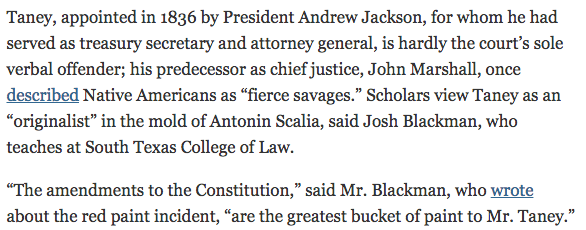Sheryl Gay Stolberg of the New York Times interviewed me about recent efforts to get rid of statues dedicated to Chief Justice Taney in Maryland. I wrote about this topic last year in the context of Taney bust at the Supreme Court, after some vandals poured red paint on a Taney bust in Frederick, MD. Distilling a 45-minute interview down to two sentences is always tricky, but I think Stolberg did a good job.

First, I attempted to convey that Taney is far from the only Justice who said things which would be unacceptable by modern standards. I am ebullient that she included John Marshall’s “fierce savages” line from Johnson v. M’Intosh, as it serves as a helpful respite from the conventional (undeserved) Marshall hagiography. I also told her about John Marshall Harlan’s barbs against Chinese people in Plessy (the forgotten parts of that dissent), Brandeis’s brief in Muller v. Oregon about the frailty of women, and Holmes’s awful attacks on “imbeciles” in Buck v. Bell. Those references didn’t make it in, but it gets the point across.
Second, the point about Taney being an “originalist” came during my discussion of Dred Scott and substantive due process. That wasn’t exactly my point, and I in fact explained that Taney totally screwed up the history of freed blacks in the North, but close enough.
Third, the quoted line should have been “The [Reconstruction] amendments to the Constitution are the greatest buckets of paint to Mr. Taney.” Truly, having Taney around serves as a reminder of how significant the 13th, 14th, and 15th Amendments were. The Supreme Court didn’t overturn Dred Scott. Article V did.